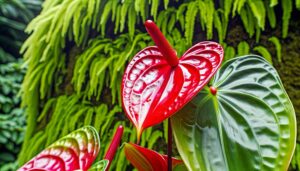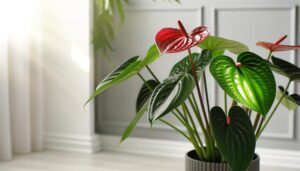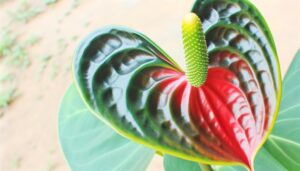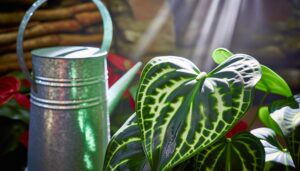Why Is Anthurium Queen of Hearts Special? Explored!
You’ll find Anthurium crystallinum ‘Queen of Hearts’ special due to its striking heart-shaped leaves adorned with prominent white veins. The velvety leaf texture and exotic origins in tropical rainforests make it a standout.
This plant thrives in high humidity and indirect light, embodying both aesthetic appeal and air-purifying qualities. Its resilient, long-lasting blooms come in vibrant hues, suitable for various indoor environments.
Genetic and environmental factors influence its growth patterns, adding to its allure. Discovering more about its care and beauty will further enhance your appreciation of this extraordinary plant.
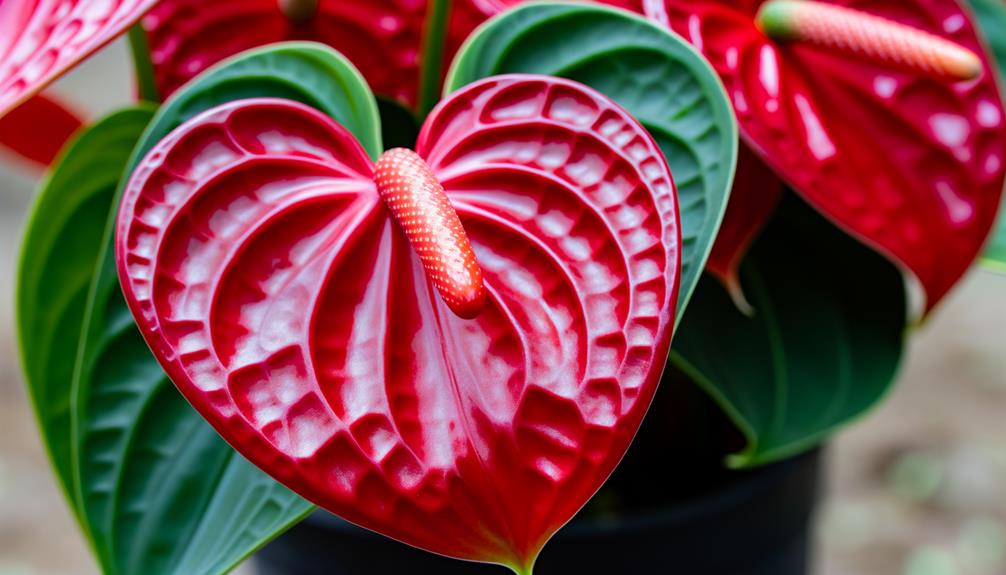
Key Takeaways
- Heart-shaped leaves with white veins offer unique visual appeal.
- Velvety leaf texture enhances elegance and exotic allure.
- Long-lasting, vibrant blooms maintain striking beauty.
- Ideal for indoor conditions with high humidity and indirect light.
- Air-purifying qualities improve indoor air quality.
Unique Aesthetic Appeal
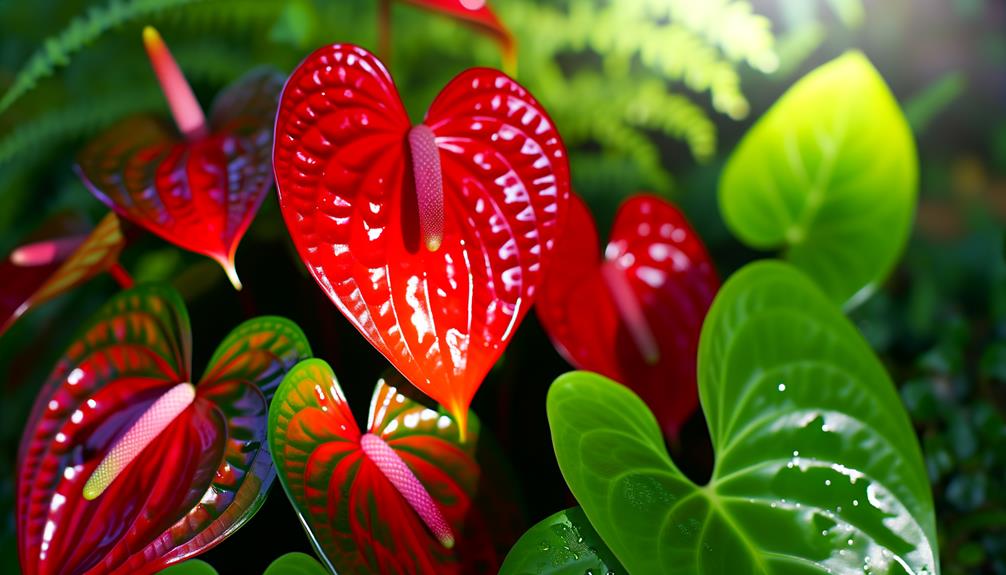
The Anthurium ‘Queen of Hearts’ captivates with its large, velvety, heart-shaped leaves that exhibit a rich, deep green hue and prominent, contrasting white veins. You’ll find these leaves possess a texture that’s both alluring and tactile, thanks to their velutinous surface.
The plant’s unique aesthetic appeal stems from its botanical classification as Anthurium crystallinum, renowned for its striking foliage. Each leaf’s pronounced venation not only enhances visual interest but also underscores the plant’s exotic allure.
This species thrives in high humidity and indirect light, making it an ideal choice for those seeking to create an indoor tropical sanctuary. Embrace this botanical marvel to elevate your space, offering both a touch of nature’s elegance and a sense of unrestrained beauty.
Heart-Shaped Foliage
Admire the Anthurium ‘Queen of Hearts’ for its distinctive, heart-shaped foliage that showcases Anthurium crystallinum’s signature velvety leaves with prominent veining.
The foliage’s unique heart shape is not only aesthetically pleasing but also a validation of its botanical accuracy.
Each leaf’s peak tapers delicately, while the basal lobes curve gracefully, embodying the traditional heart silhouette. The leaves’ surface area maximizes photosynthesis efficiency, promoting strong growth.
| Feature | Description | Significance |
|---|---|---|
| Shape | Heart-shaped | Visual appeal, botanical precision |
| Venation | Prominent, contrasting veins | Enhanced nutrient distribution |
| Apex/Taper | Finely tapered peak, rounded lobes | Traditional heart silhouette, accuracy |
This flawless form makes each leaf a living masterpiece, perfect for any indoor space seeking natural grace.
Velvety Leaf Texture
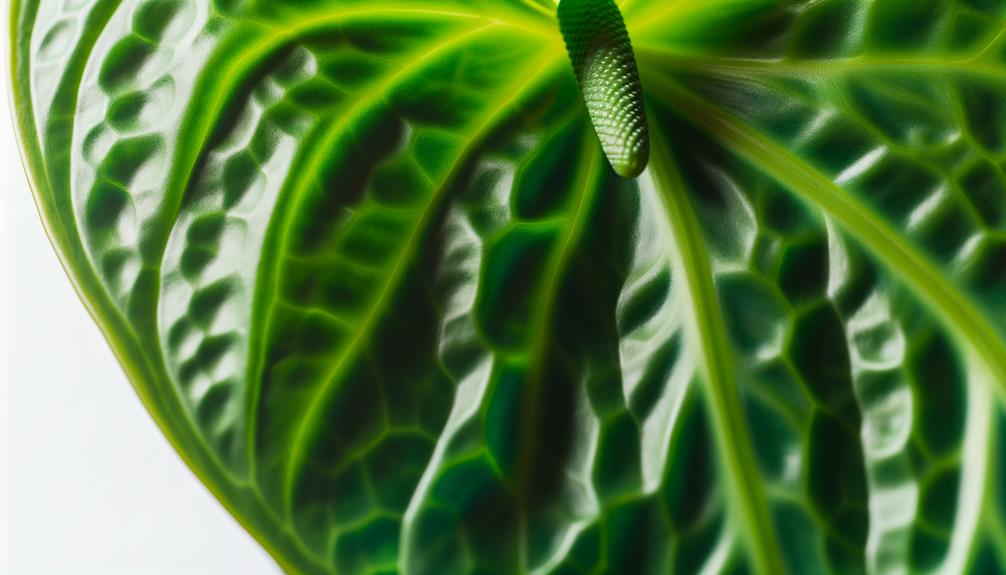
You’ll immediately notice the velvety texture of Anthurium ‘Queen of Hearts’ leaves, a characteristic derived from its dense layer of trichomes that give the foliage a soft, tactile quality.
These microscopic hair-like structures, known scientifically as trichomes, act as a protective barrier, reducing moisture loss and shielding the plant from herbivores.
The velvety surface reflects light in a unique manner, adding an iridescent sheen that enhances its visual appeal.
The texture isn’t just for show; it plays an essential role in the plant’s physiology by aiding in transpiration and gas exchange.
You’ll find that this specialized leaf structure embodies both elegance and function, making Anthurium ‘Queen of Hearts’ a remarkable specimen for any enthusiast seeking botanical freedom.
Exotic Plant Origins
You’ll find that Anthurium ‘Queen of Hearts’ traces its lineage to the dense, humid canopies of tropical rainforests, specifically within the Araceae family.
Its unique growing conditions include consistently high humidity levels, indirect sunlight, and well-draining, organic-rich substrates.
Understanding its native habitat significance helps you replicate these conditions for best growth and vibrant foliage.
Tropical Rainforest Origins
Nestled within the dense canopies of Central and South America’s tropical rainforests, the Anthurium crystallinum, often referred to as the ‘Queen of Hearts,’ thrives in the humid, nutrient-rich environment.
You’ll find this epiphytic marvel clinging to tree trunks, its velvety, heart-shaped leaves glistening under filtered sunlight.
The rainforest’s high humidity and frequent rainfall create the perfect microclimate for this plant’s growth. Anthurium crystallinum’s aerial roots absorb moisture directly from the air, while its large, dark green leaves, marked with striking white venation, maximize photosynthesis.
The plant’s native habitat offers a dynamic ecosystem where it competes for light and nutrients, fostering resilience and adaptability. Embracing its exotic origins connects you to nature’s untamed splendor.
Native Habitat Significance
Understanding the native habitat of Anthurium crystallinum, primarily the tropical rainforests of Central and South America, highlights the importance of replicating these specific environmental conditions for ideal growth. You’ll need to mimic the humid, shaded understory where these epiphytic plants thrive. Guarantee high humidity levels (60-80%), temperatures between 65-80°F (18-27°C), and indirect lighting.
Anthurium crystallinum prefers well-draining substrates rich in organic matter, similar to decomposing leaf litter found on rainforest floors. Using a mix of orchid bark, peat, and perlite can simulate this environment. Avoid waterlogging roots, as it leads to rot.
Growth Patterns
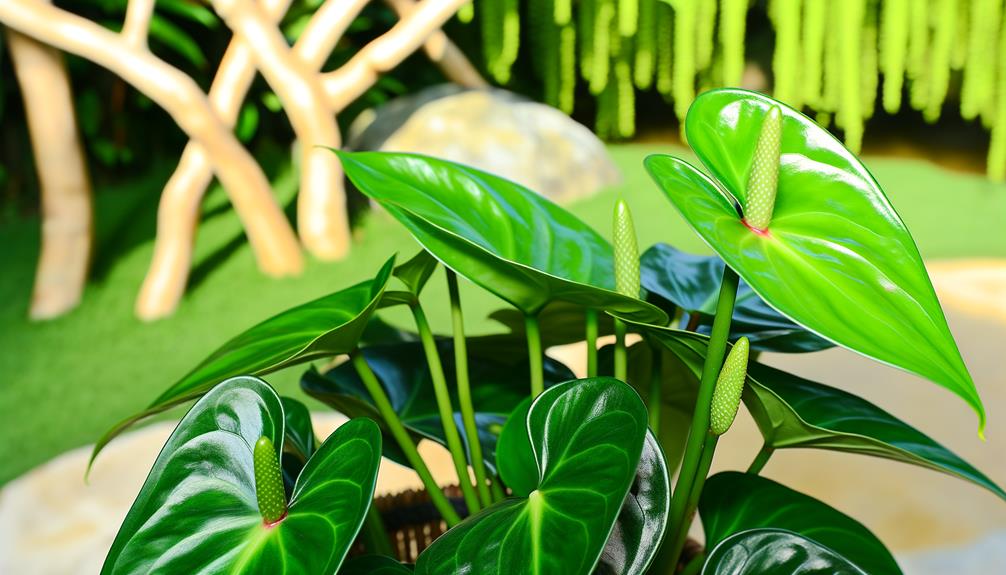
You’ll observe that Anthurium warocqueanum, commonly known as the Queen of Hearts, exhibits remarkable leaf size evolution, characterized by substantial increases in lamina length and width over time.
The root development traits include robust, aerial root systems that emerge from the nodes, facilitating nutrient absorption and anchorage.
Additionally, seasonal growth changes are prominent, with accelerated vegetative growth during the wet season, influenced by temperature and humidity variations.
Leaf Size Evolution
The leaf size evolution in Anthurium ‘Queen of Hearts’ showcases distinct growth patterns characterized by the enlargement of foliar surfaces, driven by genetic factors and environmental influences.
You’ll notice that the species displays heteroblasty, where juvenile leaves differ in size and shape from mature leaves. The genetic makeup, especially alleles involved in cell expansion, dictates this growth.
Additionally, factors like light intensity (photosynthetically active radiation) and humidity directly impact leaf area and thickness.
| Factor | Impact on Leaf Size |
|---|---|
| Genetic Makeup | Determines potential maximum size |
| Light Intensity | Influences leaf area expansion |
| Humidity | Affects leaf thickness and size |
| Nutrient Availability | Supports best growth |
| Temperature | Modifies metabolic rates |
Understanding these elements allows you to enhance growth conditions, harnessing the plant’s potential for larger, healthier leaves.
Root Development Traits
Just as leaf size in Anthurium ‘Queen of Hearts’ is shaped by genetic and environmental factors, root development traits exhibit intricate growth patterns influenced by nutrient availability and substrate composition.
You’ll notice that Anthurium roots, particularly in Anthurium crystallinum and Anthurium clarinervium, demonstrate extensive lateral branching and fibrous root systems.
Best growth requires a well-draining substrate rich in organic matter, such as a mix of sphagnum moss, perlite, and orchid bark. This composition ensures sufficient aeration and moisture retention.
Roots actively absorb essential nutrients like nitrogen, phosphorus, and potassium, which are crucial for overall plant health.
The balance of these nutrients affects root elongation and density, contributing to the robust and resilient nature of Anthurium ‘Queen of Hearts’.
Seasonal Growth Changes
As seasons change, Anthurium ‘Queen of Hearts’ displays distinct growth patterns, with accelerated leaf and root development during the warmer, humid months.
You’ll notice that Anthurium crystallinum thrives when temperatures range between 70-85°F (21-29°C) and humidity stays above 60%.
Here’s what to expect:
- Spring and Summer: Vigorous growth with new leaves unfurling and roots extending rapidly.
- Fall: Slowed but steady development, as the plant prepares for dormancy.
- Winter: Minimal growth; the plant conserves energy and moisture, leading to reduced watering needs.
- Transition Periods: Light adjustments in care, including moderated watering and fertilization.
Understanding these growth patterns helps you provide excellent care, ensuring your Anthurium ‘Queen of Hearts’ flourishes year-round.
Easy Care Requirements
Caring for Anthurium Queen of Hearts involves maintaining ideal humidity levels, ideally between 60% and 80%, to mimic its native tropical habitat. You should use a hygrometer to monitor humidity accurately.
Position the plant in indirect, bright light; Anthurium crystallinum thrives in filtered sunlight to avoid leaf scorching.
Watering should be consistent but not excessive—use lukewarm water and make sure the potting mix is well-draining, preferably containing equal parts orchid bark, perlite, and peat moss.
Fertilize monthly during the growing season with a balanced, water-soluble fertilizer diluted to half strength.
Keep temperatures between 65°F and 80°F (18°C and 27°C) and avoid drafts. Pruning dead leaves will promote healthy growth.
Suitable for Indoors
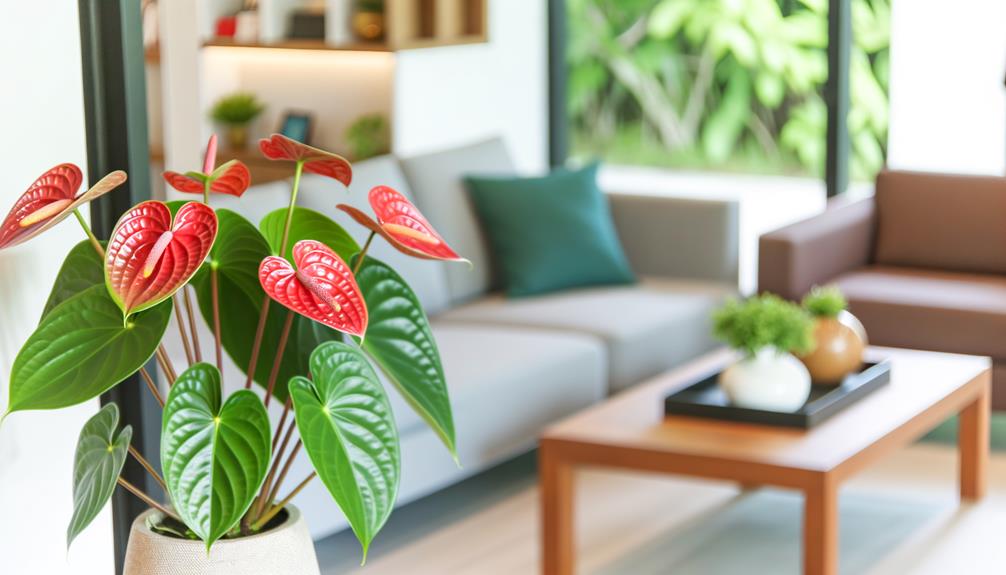
Given its adaptability to controlled environments, Anthurium Queen of Hearts (Anthurium crystallinum) makes an excellent indoor plant that enhances living spaces with its striking foliage.
The vibrant, heart-shaped leaves with prominent veins thrive under indirect light and offer a lush, tropical aesthetic.
You’ll appreciate:
- Low Light Tolerance: Prefers bright, indirect sunlight but tolerates lower light conditions, making it versatile for different indoor settings.
- Humidity Needs: Thrives in higher humidity levels (60-80%), which you can achieve through humidifiers or pebble trays.
- Temperature Range: Best growth occurs between 65-75°F (18-24°C), suitable for most indoor climates.
- Air Circulation: Requires good air circulation to prevent fungal infections, so avoid cramped spaces.
It’s a plant that fits perfectly into your dynamic lifestyle.
Air Purifying Qualities
The Anthurium Queen of Hearts (Anthurium crystallinum) actively filters airborne toxins like formaldehyde and ammonia, contributing to a healthier indoor environment. Its large, velvety leaves, rich in stomata, effectively absorb volatile organic compounds (VOCs) and convert them into less harmful substances.
You’ll appreciate the plant’s dynamic role in improving air quality through phytoremediation. The process of gas exchange in the mesophyll tissues aids in purifying the air, making your living space fresher and safer.
Additionally, the plant’s robust root system enhances this filtration by absorbing contaminants from the soil. By incorporating the Anthurium crystallinum into your home, you’re not just adding aesthetic value but also harnessing a natural air purifying powerhouse.
Bloom Characteristics
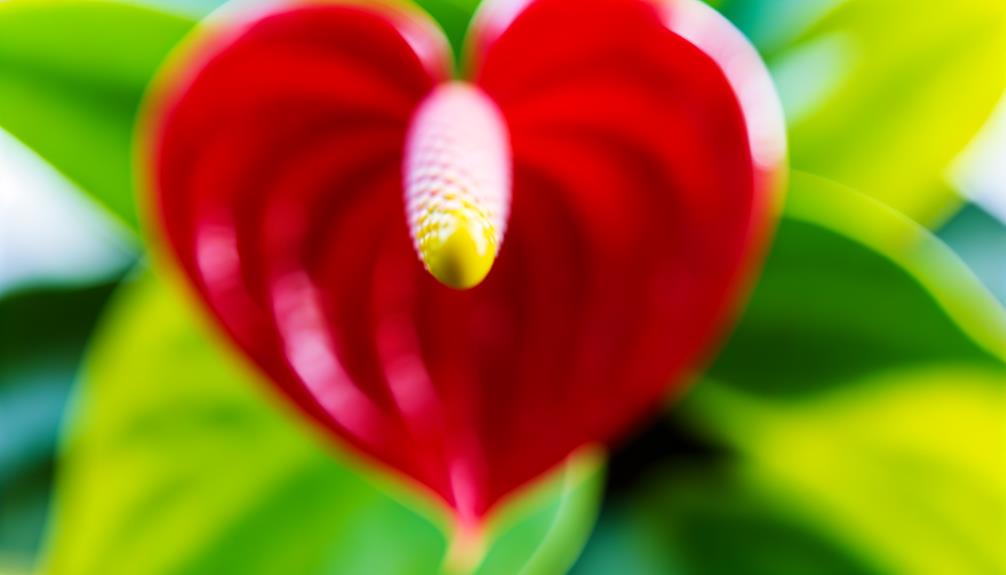
You’ll find Anthurium andraeanum, known as Queen of Hearts, exhibits striking heart-shaped spathes, a defining characteristic.
These blooms not only captivate with their longevity, often lasting up to six weeks, but they also come in a spectrum of vibrant hues, from deep reds to bright pinks.
Each flower’s glossy texture and vivid coloration make them a standout in any botanical collection.
Unique Heart-Shaped Blooms
Each Anthurium ‘Queen of Hearts’ bloom showcases a distinctive cordate shape, scientifically known as cordiform, characterized by its vibrant spathe and prominent spadix.
You’ll notice the following unique features:
- Spathe: The heart-shaped spathe varies in hues, from deep red to pink, serving as a modified leaf that attracts pollinators.
- Spadix: The central spadix, often white or yellow, stands erect and is densely packed with tiny flowers.
- Venation: Prominent venation is visible on the spathe, adding texture and visual interest.
- Glossy Finish: The spathe’s waxy, glossy finish enhances its vivid coloration and longevity.
These characteristics make each bloom a striking, resilient feature in your garden, encouraging liberation from the mundane.
Long-Lasting Flower Lifespan
Anthurium ‘Queen of Hearts’ blooms exhibit remarkable longevity, often retaining their vibrant appearance for several weeks.
The spathes (modified leaves) and spadices (flower spikes) possess high resistance to wilting and discoloration, making them ideal for long-term display.
Their extended lifespan is attributed to the plant’s robust cellular structure and efficient water retention mechanisms.
| Feature | Description |
|---|---|
| Spathe Texture | Thick, waxy, and resilient |
| Spadix Lifespan | Can last up to 6-8 weeks |
| Water Retention | Exceptional due to cellular structure |
| Wilting Resistance | High, minimal maintenance required |
| Discoloration | Rare, retains color for weeks |
Vibrant Color Varieties
The ‘Queen of Hearts’ Anthurium offers a stunning array of vibrant color varieties, including deep reds, bright pinks, and pure whites, each displaying a unique combination of spathe and spadix hues.
These enchanting colors, primarily observed in Anthurium andraeanum, create a visual feast. You’ll appreciate the intricate beauty of each bloom’s details.
- Deep Reds: Rich, velvety spathes paired with contrasting yellow spadices.
- Bright Pinks: Vivid pink spathes complemented by white or yellow spadices.
- Pure Whites: Elegant white spathes with striking yellow or green spadices.
- Bicolor Varieties: Unique blends where the spathe and spadix exhibit different colors, enhancing visual interest.
Each variety’s chromatic brilliance brings freedom to your indoor garden, making it a focal point of natural artistry.
Versatile Decorative Use
Frequently, the Anthurium andraeanum ‘Queen of Hearts’ provides a striking focal point in interior design, thanks to its vibrant spathes and glossy, heart-shaped leaves.
You can place it in a contemporary living room, where its vivid red or pink spathes (modified leaves) contrast beautifully with neutral tones.
Its adaptability to various lighting conditions, from bright indirect light to low light, makes it an ideal choice for diverse environments.
The ‘Queen of Hearts’ also thrives in well-draining potting mixes rich in organic matter, ensuring robust growth and longevity.
Whether you’re decorating a minimalist office or a cozy reading nook, this Anthurium’s unique morphology and air-purifying properties enhance both aesthetic appeal and indoor air quality.
Popular Among Collectors

With its striking spathes and heart-shaped leaves, the Anthurium andraeanum ‘Queen of Hearts’ has garnered a dedicated following among plant collectors for its unique aesthetic and relatively easy care requirements. You’ll find this species particularly appealing due to its:
- Vibrant Spathes: The spathes exhibit a glossy sheen and come in various shades of red, pink, and white.
- Heart-Shaped Leaves: The foliage isn’t only heart-shaped but also robust and glossy, making it a visual delight.
- Long-Lasting Blooms: The plant’s blooms can last several weeks, offering enduring beauty.
- Minimal Care Needs: Thrives in well-draining soil with moderate watering and indirect light, making it suitable for both novice and experienced collectors.
This plant’s enchanting features and manageable maintenance make it a collector’s gem.
Long-Lasting Beauty
Anthurium andraeanum ‘Queen of Hearts’ captivates with its enduring blooms, which can maintain their stunning appearance for several weeks, providing sustained visual interest.
This species boasts long-lasting bracts, or modified leaves, that are heart-shaped and vibrant. The spadix, where tiny flowers cluster, remains robust, offering consistent beauty.
You’ll appreciate how the inflorescence retains its vivid color, thanks to high concentrations of anthocyanins and carotenoids. Its thick, waxy texture reduces water loss, prolonging freshness.
You won’t need to replace blooms frequently, giving you more time to enjoy their splendor. Ideal for your dynamic lifestyle, Anthurium ‘Queen of Hearts’ offers an enduring natural masterpiece, blending seamlessly into diverse environments, making it perfect for those who seek aesthetic resilience and freedom.
Conclusion
To sum up, the Anthurium ‘Queen of Hearts‘ captivates with its heart-shaped, velvety leaves and exotic origins. It’s not just beautiful; it’s resilient too, with blooms that last up to 8 weeks.
As an Anthurium crystallinum hybrid, it’s a collector’s gem, offering both aesthetic and botanical value. Whether you’re an enthusiast or a novice, this plant’s unique attributes make it a versatile and enduring addition to any collection.

